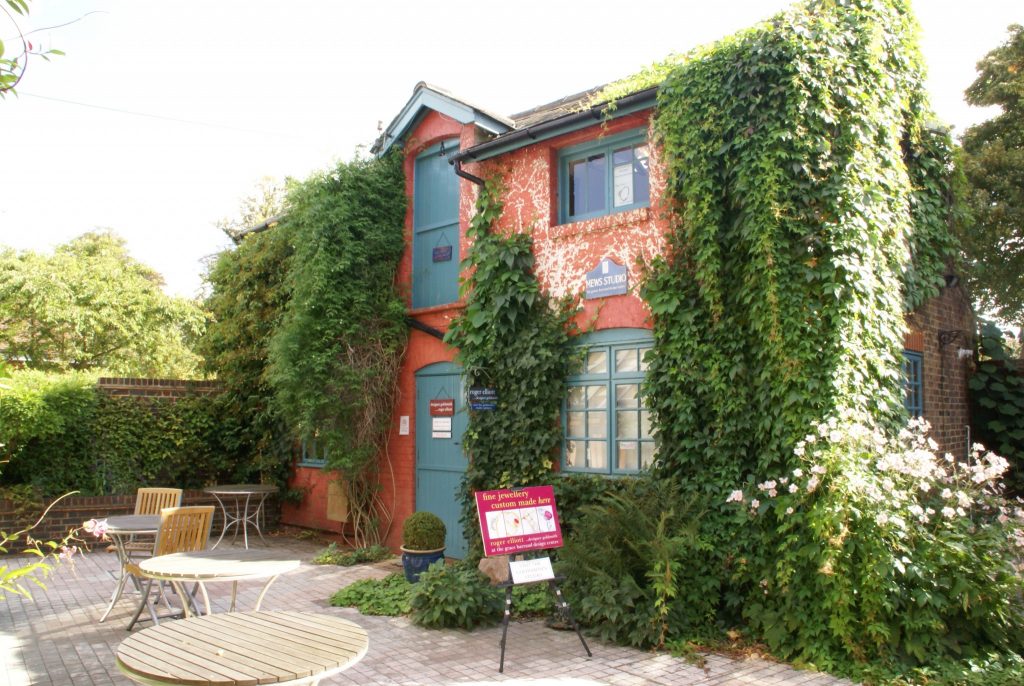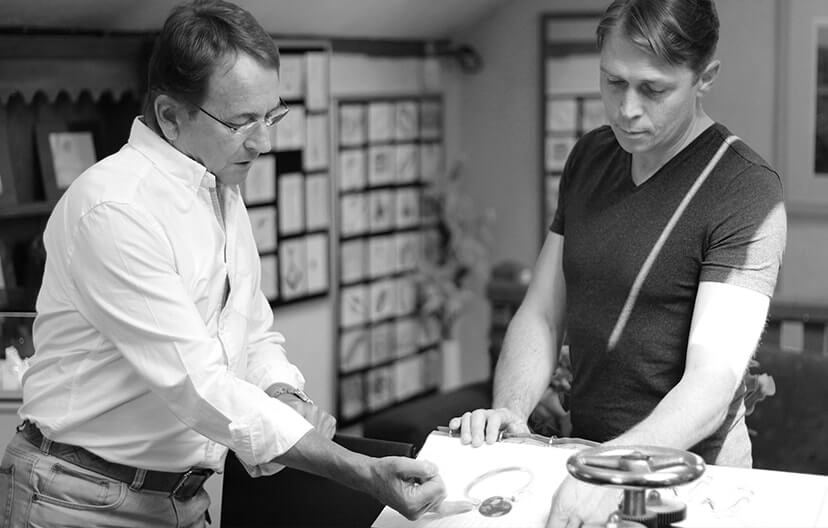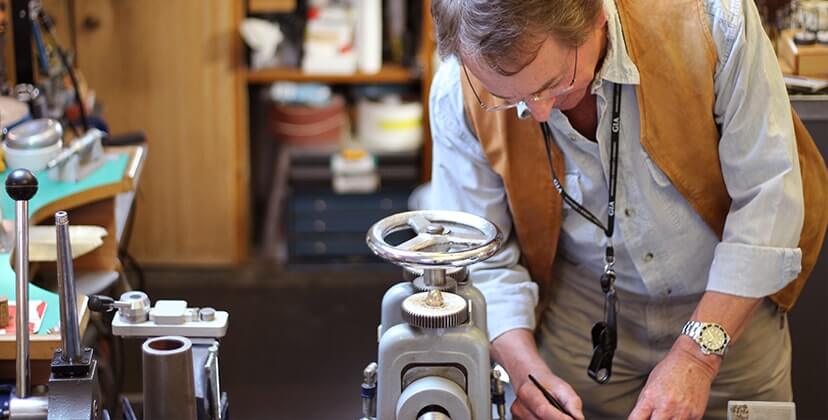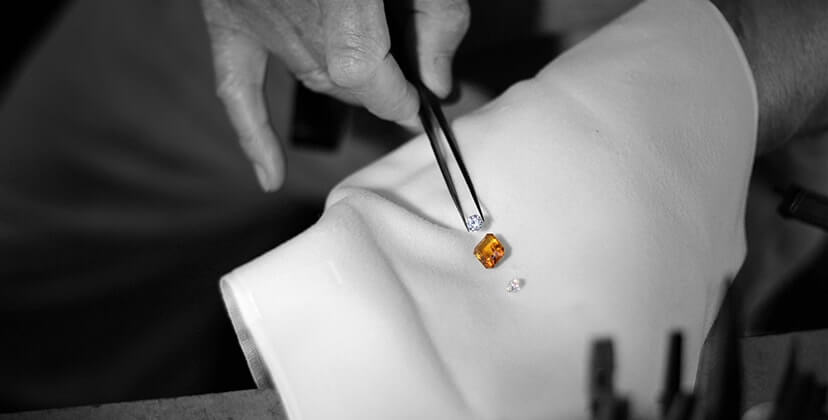A delightful journey from The Wish
to The Possession
– with a talented designer as your guide.
Getting to know each other
The role of the bespoke jewellery designer-maker is to understand what the client wants and then create it. We must first become familiar with your style, tastes and preferences so that we can advise on the detail of your initial idea – or to help you form that idea in the first place. At the same time you will want to assess the designer to be sure you are choosing the right person you can trust to achieve your dream – is Roger on your wavelength?
This requires time to be spent simply getting to know each other and exploring common ground. The relaxing, informal Mews Studio with its integral workshop; the absence of any sense of hurry and our friendly approach generates the ideal environment to achieve this.

Viewing, learning about, and selecting
the stone or stones.
Once initial ideas for the basic design concept have been discussed, the gemstone (or stones) is usually the best place to begin working toward a detail design. The type, shape, size and quality of the stone is settled by discussing basic preferences of colour, bold or delicate appearance and approximate budget. Once we have established whether we are looking for diamond, one of the many colours of sapphire, ruby, emerald, black opal or other precious gems, the shape is the next thing to consider. Whether a classic round diamond, oval or rectangular sapphire etc or a less conventional Asscher, cushion, pear or ‘emerald-cut’ and so on – the choice is extensive.

For bespoke work we believe it only makes sense to use high quality stones. A low grade diamond or overly dark sapphire would let down the final piece. We have our own standards for stone quality that we never lower – akin to what you might term ‘Bond Street Quality’. However, there is still a choice to be made between a very good stone in a larger size or an absolutely superb one but perhaps a slightly smaller size – a matter of taste and budget. To make the choice, once a rough idea of budget or stone size is established we will offer a selection of, typically six or seven stones for you to view. At this point we can explain and show you the differences in quality so that you can make an informed choice.
Agreeing on a design and its detailing.
Roger is an exceptionally talented designer – but your preferences are paramount. So all the aspects of the piece are discussed at this time. Examples of the types of stone setting – bezel, rub-over, channel, gypsy, pavé, claw, tension, end-set etc. – will be shown and pros, cons and preferences discussed. Similarly the details for the body of the piece (e.g. the shank for a ring) will be determined jointly between you and the designer. It is then the designer’s role to make the concept ‘work’ as a balanced and stylish piece.

You will be asked your personal preferences for the material – yellow gold, white gold, rose gold or platinum-and advantages and disadvantages of the various options will be explained. For fine quality bespoke work we believe in only working with a gold in either 18 or 22 carat grades. The alternative white metal, of course, is platinum – though palladium can be a useful option for certain pieces where minimum weight is a consideration.
The creation of your piece in the workshop
Your jewellery will be made in the studio. It may be hand formed from the raw precious metal in bar, tube or sheet form. Alternatively, depending on the design, a wax model may be produced, a mould made, and the piece cast from molten gold or platinum. The wax model may be produced by hand carving or via a CAD computer system.

A ring shank, or band, must be made to suit the finger size, and bracelets must suit the wrist. The collets (the part that holds the stone) must be made to suit the size and shape of the selected stone and the chosen style of setting .
A good deal of workshop time is used in perfecting, finishing and primary polishing the initial ‘rough’ – whether hand formed or cast.

Stones are set last in the construction of the piece but before final polishing. Notches or grooves are cut to receive the stone’s girdle (the outer edge of any stone). The precious metal is then burnished, pushed or bent over that outer edge of the stone to secure it. In some settings, pavé for example, several grains or small beads are raised out of the background metal and formed over the edge of the stone. Each grain may partly secure one, two or four stones.
Finally the piece is highly polished using a progression of mildly abrasive ‘soaps’ on a spinning mop or brush. If the piece is of white gold the convention in the jewellery trade is to coat it with rhodium (a sister metal to platinum) to match the colour of platinum. Since, however, we only use the highest, whitest grade of palladium-rich white gold, some clients prefer it without the rhodium coating.
The Assay Office then adds the traditional hallmark, assuring the quality of the gold or platinum as well as recording the maker and date on the piece.
A stylish, polished wood, leather lined box completes the presentation to the, invariably delighted, client.
Roger’s jewellery is often created for a special occasion but it is made to be worn every day.
Gem and Materials Quality.
Commissioning truly bespoke-made jewellery should be both a treat and an experience – but only when the quality is of the highest standard. Second only in our book to matching the client’s requirements in design, comes quality of the final piece.
Perfection is aimed for in all aspects of the craftsmanship involved in making each piece.

Only high grade gemstones are ever supplied for our jewellery (mediocre gemstone look less attractive than today’s fakes!). Diamonds are supplied in grades from G VS to D Flawless – with certificates for all over a half carat. Our smaller diamonds are described as ‘FVS1+’ this indicates that these small stones are uncertificated but judged to be of F colour or better and VS1 clarity or better.
Gold, whether yellow or white, is only used in 18ct grade or above. The 18ct White Gold used is of a higher quality than often found in jewellery today. Only palladium rich, high white material is used to ensure the whiteness is permanent. Platinum is offered as a top-end alternative for any piece of jewellery – though its greater weight must be taken into account – for example when considering substantial designs of earrings or necklaces.
These, and countless other details are all part of our determination to provide truly fine quality, bespoke-made jewellery.
See some client stories in A Closer Look
“Roger Elliott is passionate about jewellery and it makes for a customer experience that is superior to any other fine jewellery shopping experience. There is none of the empty pretentiousness of a luxury jewellery shop one encounters elsewhere and there is plenty of advice, sound knowledge of gems, original design, and fair pricing. At Roger Elliott’s studio custom-made means exactly that – every piece is unique and to the customer’s specific wishes. I have had two jewellery pieces produced there in the past three years and both are absolutely fantastic. Like many of Roger’s customers, I will be back again.”
